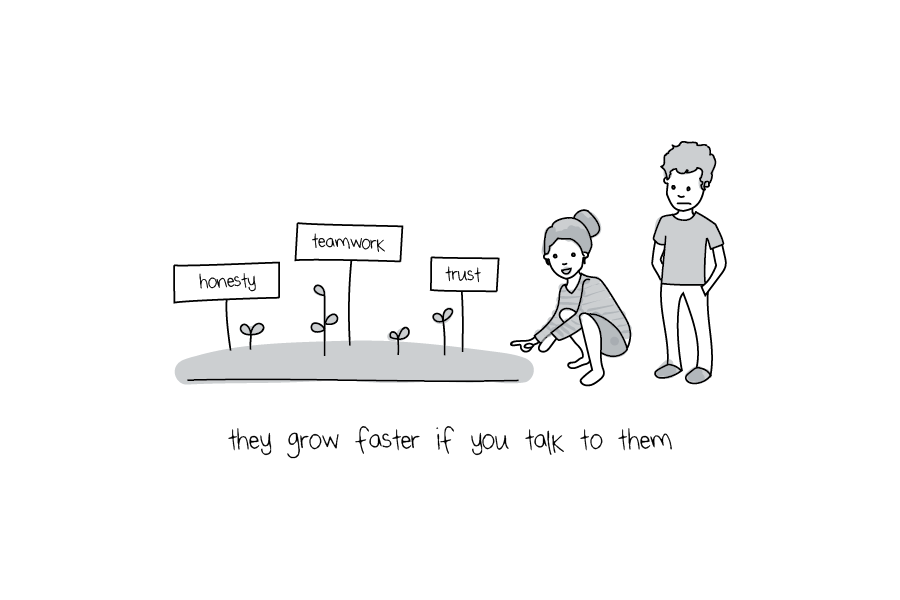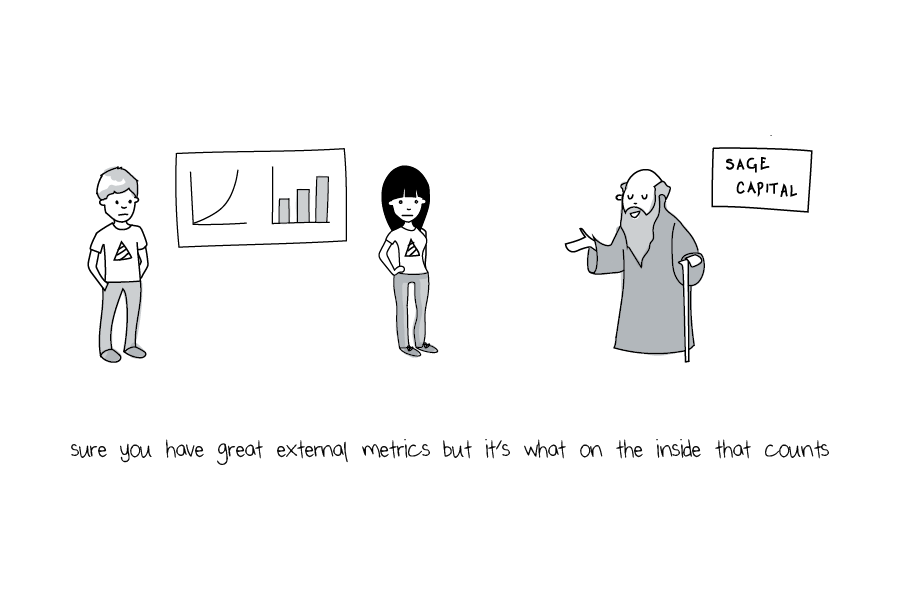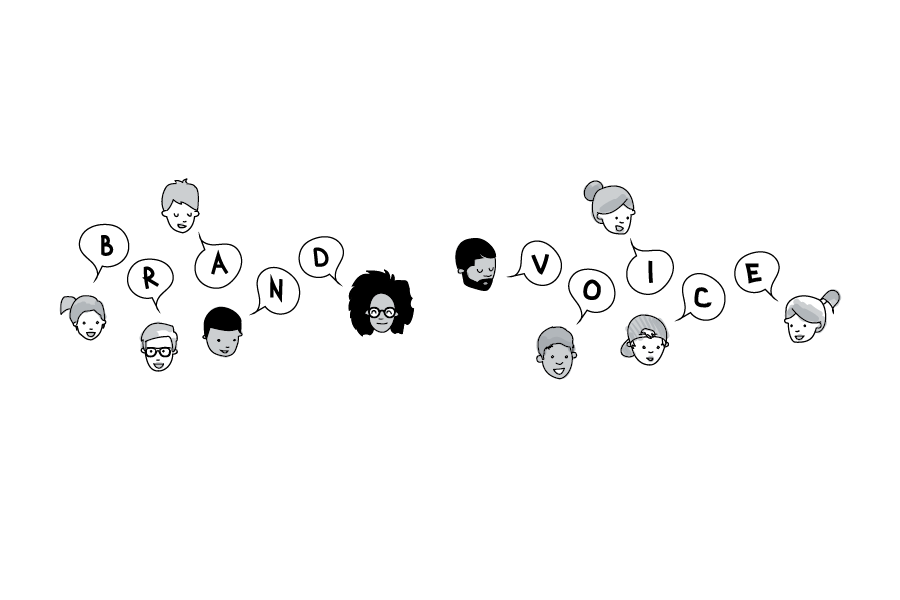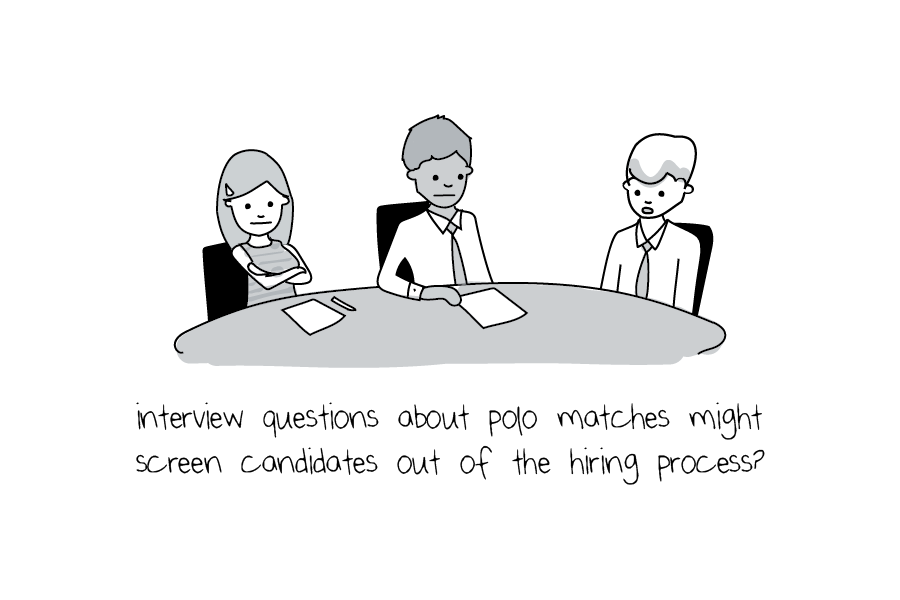Sure, founders set a tone. But they aren’t the only ones who shape workplace culture, writes Ideo’s Mollie West.

Photo: Thomas Barwick/Getty Images. Illustrations: Liz Fosslien
We all fear the job that looks great on paper and is a nightmare in practice. What makes some companies great to work for and others a disaster? The answer: good workplace culture. It’s the difference between Google and Yahoo, Costco, and the Department of Corrections. Studies have shown that office culture is one of the most revealing indicators of workplace satisfaction. How can companies be intentional about building and nurturing a good workplace culture?
The short answer: Hire for the right roles. Some people believe that founders are the only ones who can create company culture. It’s true that founders are usually responsible for creating the original values. Consider how Larry Page and Sergey Brin from Google defined the way they wanted their first dozen employees to feel at work. In fact many of the best-loved parts of the culture started before Google had 50 employees.
But as a company grows, there are still opportunities for cultural recalibration. Here are seven roles of people who help define, harness, reflect, and embody culture. Think of them as the new faces of organizational culture.
 1. THE GARDENER
1. THE GARDENER
Exemplar: Company Founder(s)
Google cofounders Larry Page and Sergey Brin had one intention for Google’s culture: They wanted to create a company that felt like their experience at Stanford’s graduate school. Page and Brin famously hired a chef to cook for Google’s first employees, a perk they had grown to love at Stanford University’s dining halls.
Beyond the free food, Google tried to mimic the actual experience and culture of being a grad student. Page observed, “When you’re a grad student, you can work on whatever you want. And the projects that were really good got a lot of people really wanting to work on them. We’ve taken that learning to Google, and it’s been really, really helpful. If you’re changing the world, you’re working on important things. You’re excited to get up in the morning. You want to be working on meaningful, impactful projects.”
Page and Brin are examples of founders who have helped nurture Google’s culture. Several culture theorists use the term “gardening” when talking about fostering good workplace culture. A few years ago, the New York Times columnist Thomas Friedman spoke with Amazon CEO Jeff Bezos about trends in technology and leadership. Friedman wrote that Bezos believes “the job of the company leader is now changing fast. ‘You have to think of yourself not as a designer but as a gardener’—seeding, nurturing, inspiring, cultivating the ideas coming from below, and then making sure people execute them.”
Google has retained many parts of its unique startup culture because Page and Brin understood that the company’s culture needed care and nurturing. The most important thing the gardener can do is to write down the company’s cultural values and share them within the company. Page and Brin wrote Google’s valueswhen the company was just a few years old.

2. THE SAGE
Exemplar: Venture Capitalist
It was 2012, and Airbnb cofounders Brian Chesky, Joe Gebbia, and Nathan Blecharczyk had just closed their Series C funding round with investor Peter Thiel. Thiel cofounded PayPal and now runs Palantir Technologies. Thiel is known for his business aptitude, and he frequently writes about his philosophical (and sometimes controversial) viewpoints, including his support of libertarianism and his belief that companies should operate with a flat structure and share company data with all employees. The Airbnb cofounders invited Thiel to their office in San Francisco. To help you picture this scene, it’s important to know that the conference rooms in the Airbnb office are designed to look like real Airbnb apartment listings from cities including New York, Berlin, and Hong Kong. They invited Thiel into the “Berlin Room” (decorated with ornate baroque wallpaper and a rococo couch) to show him various metrics. In the middle of the conversation, Chesky asked Thiel what his single most important piece of advice for them was.
Thiel replied, “Don’t fuck up the culture.”
Thiel is an example of a sage, a wise veteran who has been through the trenches of starting a company before. The most important thing a sage can do is to remind a company to focus on culture. Founders often feel like they have no time to focus on company culture, when it is actually the most important thing they should be focused on. Jerry Colonna, a former venture capitalist at Flatiron Partners and current CEO coach, is known as the Yoda of Silicon Valley. His Yoda wisdom? “Even if you are not intentional about your culture, you will still have one.”

3. THE EMPATHIZER
Exemplar: The Recruiter
Let’s say I’ve just stayed at an Airbnb, and I’ve had a great experience using the service. I’m on the website, leaving a review, and I navigate down to the careers page. I already have a job I love, but I’m just curious (we’ve all been there). Within two minutes, I have learned what Airbnb’s cultural values are and specifically what traits and values Airbnb is looking for in candidates. But what really hooks me is learning what it’s like to work at Airbnb. I see that employees get to have “fireside chats” with industry leaders and musicians like Will.I.Am. I learn what it’s like for employees to work at Airbnb every day. And not just employees, in the generic sense. Specifically, videos on what it’s like for interns, developers, and even moms to work at Airbnb. There’s also a huge section on what the engineering culture is like (hilariously, at nerds.airbnb.com).
Airbnb has carefully mapped out what comes next. Jill Riopelle, head of recruiting, used a design technique called journey mapping to gain empathy for the candidates going through Airbnb’s job application process. She hosted a brainstorming session in the Airbnb lunch room, and asked Airbnb employees to reflect on their own best and worst hiring moments. Next, they brainstormed how they wanted applicants to feel at each point and mapped out the ideal process for both the applicant and the hiring team. Based on these ideas for an “ideal process” Airbnb made the communication process with applicants more high touch (applicants get more updates, and aren’t wondering when the company will respond). When applicants first apply, they receive a warm acknowledgement message via email. The email “outlines next steps and suggests what candidates could do in the interim (watch company culture videos, read our FAQs, and more).” Airbnb started offering rejected applicants a chance to get feedback on the phone, which helps applicants stay positive toward the company, even if they didn’t get a job. The result? The company has more people applying a second time around, but with more experience and understanding of which roles would be right for them. It’s as if the recruiter is offering an olive branch, or playing the role of a coach or therapist.
The role of the recruiter is no longer just to find talent. It is to understand and empathize with their applicants, and then help make their experience better.

4. THE TALENT GURU
Exemplar: HR Manager
In 2009, Netflix published its seminal culture deck. Ostensibly an internal-only document that was slipped out to Slideshare, it immediately drew massive attention from the business world. The person behind this deck was former chief talent officer Patty McCord. McCord was willing to question all the old-school rules of traditional HR. In 2014, Harvard Business Review published McCord’s approach to “reinventing” human resources. McCord helped Netflix attract top talent by coming up with a new approach: “Hire, reward, and tolerate only fully formed adults.” Netflix believes the best thing they can do for employees is hire only “A” players to work alongside them. Excellent colleagues trump everything else.
McCord let go of people whose skills no longer fit with the company. To keep their “A” players happy, she instituted policies that provided freedom, responsibility, and excellent benefits that are flexible around employees’ needs. Instead of creating benefits packages based on HR rules and policies, McCord created benefits packages based on the company’s values and employees’ core motivations.
The role of the chief talent officer is no longer to blindly push through outdated HR policies. Instead, talent gurus must reinvent the company’s policies to match the company’s cultural values and employees’ personal values. Most importantly, talent gurus create the narrative that defines how a company aligns its actions (the what) with its values (the how).

5. THE DEAN
Exemplar: Learning and Developing Leader
Here’s how Randy Nelson describes himself on his LinkedIn page: “I work with organizations to make the best use of the people, wisdom, and skills they already have, want to attract, and need to develop. I help build amplifiers out of groups, using appropriate and dynamic mixtures of training and education, traditional skills, and innovative technology, flexible programs, and high standards. In addition to increased productivity and effectiveness, hijinks and shenanigans sometimes result.”
Nelson was the dean of Pixar University for 12 years, and now he is the director of Apple University. Nelson’s role is creating professional development programs that not only train employees but actually help educate employees. At Pixar, he conceived of a program that lets employees choose from 14 classes per week, including ballet, improv, drawing, and painting skills, computer programming, belly dancing, and color theory. This keeps Pixar’s talent learning and growing, thus making better films.
Pixar president Ed Catmull writes in his book, Creativity, Inc., that the magic of Pixar University “wasn’t that the class material directly enhanced our employees’ job performance. Instead, there was something about an apprentice lighting technician sitting alongside an experienced animator, who in turn was sitting next to someone who worked in legal or accounting or security—that proved immensely valuable. In the classroom setting, people interacted in a way they didn’t in the workplace. They felt free to be goofy, relaxed, open, vulnerable. Hierarchy did not apply, and as a result, communication thrived. Simply by providing an excuse for us all to toil side by side, humbled by the challenge of sketching a self-portrait or writing computer code or taming a lump of clay, Pixar University changed the culture for the better.”
Deans can play the role of fostering collaboration and creativity. They can help employees regain the mindset of being students again. When we’re learning, we retain a sense of possibility— and that sense of possibility is integral to Pixar’s whimsical success.

6. THE STORYTELLER
Exemplar: Collective Voice of Individual Storytellers
How does Ideo attract talent and clients? Ideo has widely shared stories about the firm’s “special sauce”—its processes, rituals, and values. Ideo’s leaders have published a dozen books, several sets of tools, and countless videos and articles about what it’s like to work at Ideo. You might think that by sharing its proprietary methods Ideo could lose business. Who is to say that another consulting firm won’t just copy what Ideo is doing?
In reality, publishing this information has only attracted more talent and more clients to Ideo. In fact, most of Ideo’s talent and clients come to Ideo, rather than Ideo seeking them out. The company has a very small recruiting budget, and only has a few recruiters (for a firm of 700 people, this is unusual). Instead of constantly attending recruiting fairs, Ideo aims to reach potential talent through stories. Ideo’s currency is in stories. Thus, it understands the tremendous value of having more than just one set of individuals sharing stories. Ideo encourages all employees to be storytellers.
Stories humanize companies. The role of the storyteller is to share his or her company’s inner personality and narrative with the broader world. At Ideo, there is room for many different voices, all sharing their own personal story as it relates to Ideo’s larger narrative. Ideo’s most well-known stories include books by Ideo founder David Kelley and his brother, Tom Kelley, CEO Tim Brown, and partner Jane Fulton Suri. But many other Ideo authors tell stories through videos, articles, case studies, and podcasts, including Fred Dust, David Aycan, Diego Rodriguez, Paul Bennett, Sina Mossayeb, Joe Brown, Roshi Givechi, Ingrid Fetell Lee, Ashlea Powell, and Duane Bray, to name a few. Each story has helped clarify and exemplify Ideo’s collective culture, mindsets, and values.

7. THE QUESTIONER
Exemplar: The Diversity Lead
A huge part of a company’s organizational culture is its hiring practices. Trying to increase diversity is like trying to change culture: Both are much harder to do when a company has become a midsize or large company. If a company is intentional about its culture and diversity when it’s small, the value of diversity will be baked into the company’s DNA.
Enter Slack: a company that started thinking about diversity when it was only two years old. Slack is a workplace communication and messaging app used by organizations like the New York Times, NASA, Airbnb, Buzzfeed, and Spotify. Slack was cofounded by four white men, but CEO Stewart Butterfield made diversity a priority once the company reached 40 employees. Slack was growing quickly, and they needed to hire quickly. When companies need to hire quickly, there is a tendency to hire people who come from employee networks, which leads to hiring people who are similar to current employees.
Slack’s vice president for people and policy, Anne Toth, is trying to break that cycle. She released a diversity report, which is unusual for such a young company. At the time of the release in September 2015, the company only had 250 employees. Its first strategy for breaking the cycle is to continuously look at its diversity hiring numbers and then make immediate adjustments, rather than waiting until the end of the year. According to PBS, Toth asks questions like, “Are we promoting women and people of color at the same rate? Are we retaining them at the same rate? Are we paying them equitably? Are they as engaged as other employees across the board?”
Slack’s second strategy is to change the types of questions interviewers ask candidates. Slack has stopped asking questions that produce answers that cannot be objectively evaluated. For example, one problematic question is, “What do you do for fun?” What a candidate does for fun isn’t relevant to that candidate’s ability to do work. Not only is this question not helpful for an interview, but it can actually lead to unconscious bias.
CONCLUSION
The richness of these personas is that anyone can adopt them, regardless of specific job function. Any of these approaches would benefit almost any role or organization. For example, applying a gardening approach is a useful mindset that extends beyond founders; many other roles can help build a narrative around how the company puts its values into practice.
What are the takeaway lessons that we can learn from all of these roles, regardless of your own role? One idea is to look for ways to take on one of these faces for an activity, a project, or just a day. Alternatively you can look for ways to engage with your organization at a larger level with a new lens. At Ideo, a group of creative employees came together as “gardeners” to create a series of videos designed to bring to life each of Ideo’s values. These videos helped plant seeds for new employees to learn about Ideo’s culture in a cinematic way. Regardless of your role, you can play a role in shaping your company’s culture. Anyone can adopt the lens of a dean, questioner, or storyteller in some capacity.
Why do these new faces matter? Workplace culture is becoming increasingly important, and increasingly shaped by a wider group of employees. Steelcase explains that “the shift toward culture may be gaining prominence as small businesses struggle to compete for talent with larger counterparts in the areas of plump paychecks and generous benefits packages. They’re beginning to recognize culture for the trump card it is, particularly with millennials used to interactive, stimulating environments.” According to a recent study from Workforce Institute and WorkplaceTrends, employees feel they have more influence over culture than ever before (although managers and HR professionals disagree). Millennials, in particular, feel that the power to shape culture lies not with the executive leaders or the HR team but with the people doing the work. It’s clear that in order to attract, retain, and engage the modern workforce, companies need to focus on culture. Thankfully, there are an expanding number of roles and people who can help with this.
We’re curious: What other faces of culture does your organization have? How are your employees adopting these new roles and faces?



